PIT
2019 — 21



The Pit has symbolically appeared here, in Podil district, where the ancient architecture is neighboring with industrial facilities, markets, clubs and new buildings. The work on the project started in 2018 with creating a model with every detail polished -filigree sketches of objects and installations. This architectural carefulness is intrinsic to the artist's practice who considers the environment of an object to be no less important than its materiality.
The project may be called the reproduction of the spontaneous event that interferes with the established course of things. Disorderly constructions in Kyiv streets - an emergency situation or road repair with fences made out of improvised materials - have become familiar to the stroller's eye. The obstacles one's attention stumbles on deform and acquire a personal meaning; the author delicately snatches out and moves the objects from their natural environment to his studio where he processes them thoroughly and combines in a single work.
Take Heed! work uses the fencing mesh from the place where the artist had his first street experiences as a child. One of them was love for graffiti which can be traced in Hunting. Both works are framed: they equilibrate the alien elements on the white background, and the glass creates a museumification effect of memories. It is the author's attempt to save and register the important places of vulnerability and observation with the help of everyday things. Each piece is valuable. However, he doesn't displace the context like in the ready-made technique but achieves an intimate dialogue with the things through their technical processing - firing spears, bending the wire, deforming the metal - and finally intentionally combines them.
The project may be called the reproduction of the spontaneous event that interferes with the established course of things. Disorderly constructions in Kyiv streets - an emergency situation or road repair with fences made out of improvised materials - have become familiar to the stroller's eye. The obstacles one's attention stumbles on deform and acquire a personal meaning; the author delicately snatches out and moves the objects from their natural environment to his studio where he processes them thoroughly and combines in a single work.
Take Heed! work uses the fencing mesh from the place where the artist had his first street experiences as a child. One of them was love for graffiti which can be traced in Hunting. Both works are framed: they equilibrate the alien elements on the white background, and the glass creates a museumification effect of memories. It is the author's attempt to save and register the important places of vulnerability and observation with the help of everyday things. Each piece is valuable. However, he doesn't displace the context like in the ready-made technique but achieves an intimate dialogue with the things through their technical processing - firing spears, bending the wire, deforming the metal - and finally intentionally combines them.
The
installation focuses on the chaotic configuration of elements of a
post-socialist city located in the middle of the hall. The torn concrete as a
component of the composition intuitively hints at the feeling of disturbing instability
and insecurity, and the log dipped into a hole - at the road that disappears
under your feet. Metal plates in the form of explosions serve as alien elements
and point to a spontaneous event: either movement or falling in the abyss. The
artist combines the roughness of materials with the model neatness of their placing.
The series of works on paper entitled Herbarium achieves the study effect with watercolor that makes the painting spontaneous and natural. The metamorphoses depicted here look both familiar and unfamiliar, like something that can evoke interest or disgust at the same time. However, after taking a careful look at the works, you begin to doubt whether these are actual plants. Or is it a potential scenario of ecological changes inside the pit?
The author demonstrates a conscious attempt to examine the environment that surrounded and formed him since his childhood. Apart from personal connotations, the project suggests widening the optics:
How does a place influence our identity? In what conditions did the 1990s generation grow up? These questions may be the overinterpretation of the social context that the author didn't intend to create. He rather processes the material objects to establish the dialogue with the place and embody the living memory - the one that, with time, becomes a fragment of diary notes or a saved image in the phone.
The series of works on paper entitled Herbarium achieves the study effect with watercolor that makes the painting spontaneous and natural. The metamorphoses depicted here look both familiar and unfamiliar, like something that can evoke interest or disgust at the same time. However, after taking a careful look at the works, you begin to doubt whether these are actual plants. Or is it a potential scenario of ecological changes inside the pit?
The author demonstrates a conscious attempt to examine the environment that surrounded and formed him since his childhood. Apart from personal connotations, the project suggests widening the optics:
How does a place influence our identity? In what conditions did the 1990s generation grow up? These questions may be the overinterpretation of the social context that the author didn't intend to create. He rather processes the material objects to establish the dialogue with the place and embody the living memory - the one that, with time, becomes a fragment of diary notes or a saved image in the phone.
Kateryna Tykhonenko
//
A steep slope. The area relatively to the rest of the city is in the low land. I'm going down the winding track. If you walk lower, you can notice the typical change of rumble, and the road itself is a buf er zone connecting two autonomous territories. The spawn point on the manhole - what I see is a pit, reinforced concrete floors and a simple tunnel pattern. The city metamorphoses dictate to look around carfully, study the local flora, select and register the typical samples. There is a herbaria collection in the studio to be updated. I work spontaneously without any safety equipment, and make streetwise notes for myself. I descend further, through the tramways. I pass by the market, turn at the church. Momentary photos of fenced hoed soil breaking through the asphalt. The fence is artfully made. I walk cautiously down the street. On the crossroads I plunge into the trench system, while hearing the variety of noises, sounds and rummaging. The pit provides the necessary resources. There are pallets on the floor which are used for selling vegetables, flowers and old books – proper construction material for the model of the place quite suitable for living. I recreate it, thoroughly double-checking each fragment. I use a ruler to check the distance from a concrete block to the metal bearing, and then from the bearing to the table edge. I take a virtual walk: duck two meters from the construction trailer and get inside through branches and the fencing mesh. The industrial zone is a small place inside a residential area which we used to avoid as kids and, it seems, capture it completely as teenagers. We spent a lot of free time there drinking, painting graffiti, exchanging the music, smoking weed and sharing ideas. The abandoned, fenced on the edges industrial oasis in the neighborhood was basically the place where we grew up. The fencing mesh which I untied carefully and then used as a material for my work was part of a long fence separating the zone from the rest of the residential area and thus protecting us from undesired communications. I have mixed feelings about this mesh. I unwind, tear, pull, sew, stitch carefully damages, observe and repeat. Emerging from under the ground, I see a local bohemia, turn left at the inappropriately sized new building. Through the darkness of pruned trunks and painted facades. In a beeline, again across the tramways. Walk several blocks, turn left, then three hundred meters along the pale red fence. Just like the paint, the graffiti spots, wet pieces of self-published posters and local ads are peeling off. The wall chooses which pictures to keep, remove or combine. The meanings of numerous I was here mix up and generate new interpretations which, in their turn, unite in an endless loop of self-reproduction. The corner with dumpsters, then along the metal fence, reading the posters. I can see only the abandoned future art center. The crossroads - carry on straight. Turn right before the non-existent club. The groceries store: a bottle of wine, avocado, cheese and loaf of bread. The main entrance to a Stalin-era apartment building, I walk up the stairs jingling keys in the dark. I'm inside, my fingers are numb, the phone says: please connect to power.
A steep slope. The area relatively to the rest of the city is in the low land. I'm going down the winding track. If you walk lower, you can notice the typical change of rumble, and the road itself is a buf er zone connecting two autonomous territories. The spawn point on the manhole - what I see is a pit, reinforced concrete floors and a simple tunnel pattern. The city metamorphoses dictate to look around carfully, study the local flora, select and register the typical samples. There is a herbaria collection in the studio to be updated. I work spontaneously without any safety equipment, and make streetwise notes for myself. I descend further, through the tramways. I pass by the market, turn at the church. Momentary photos of fenced hoed soil breaking through the asphalt. The fence is artfully made. I walk cautiously down the street. On the crossroads I plunge into the trench system, while hearing the variety of noises, sounds and rummaging. The pit provides the necessary resources. There are pallets on the floor which are used for selling vegetables, flowers and old books – proper construction material for the model of the place quite suitable for living. I recreate it, thoroughly double-checking each fragment. I use a ruler to check the distance from a concrete block to the metal bearing, and then from the bearing to the table edge. I take a virtual walk: duck two meters from the construction trailer and get inside through branches and the fencing mesh. The industrial zone is a small place inside a residential area which we used to avoid as kids and, it seems, capture it completely as teenagers. We spent a lot of free time there drinking, painting graffiti, exchanging the music, smoking weed and sharing ideas. The abandoned, fenced on the edges industrial oasis in the neighborhood was basically the place where we grew up. The fencing mesh which I untied carefully and then used as a material for my work was part of a long fence separating the zone from the rest of the residential area and thus protecting us from undesired communications. I have mixed feelings about this mesh. I unwind, tear, pull, sew, stitch carefully damages, observe and repeat. Emerging from under the ground, I see a local bohemia, turn left at the inappropriately sized new building. Through the darkness of pruned trunks and painted facades. In a beeline, again across the tramways. Walk several blocks, turn left, then three hundred meters along the pale red fence. Just like the paint, the graffiti spots, wet pieces of self-published posters and local ads are peeling off. The wall chooses which pictures to keep, remove or combine. The meanings of numerous I was here mix up and generate new interpretations which, in their turn, unite in an endless loop of self-reproduction. The corner with dumpsters, then along the metal fence, reading the posters. I can see only the abandoned future art center. The crossroads - carry on straight. Turn right before the non-existent club. The groceries store: a bottle of wine, avocado, cheese and loaf of bread. The main entrance to a Stalin-era apartment building, I walk up the stairs jingling keys in the dark. I'm inside, my fingers are numb, the phone says: please connect to power.
Oleksii Polovets
2020—21
90x120x400 cm (table size)
Concrete, wood, firing, metal, fencing mesh, thread, nails, mountings, bearings
︎︎︎ ︎︎︎


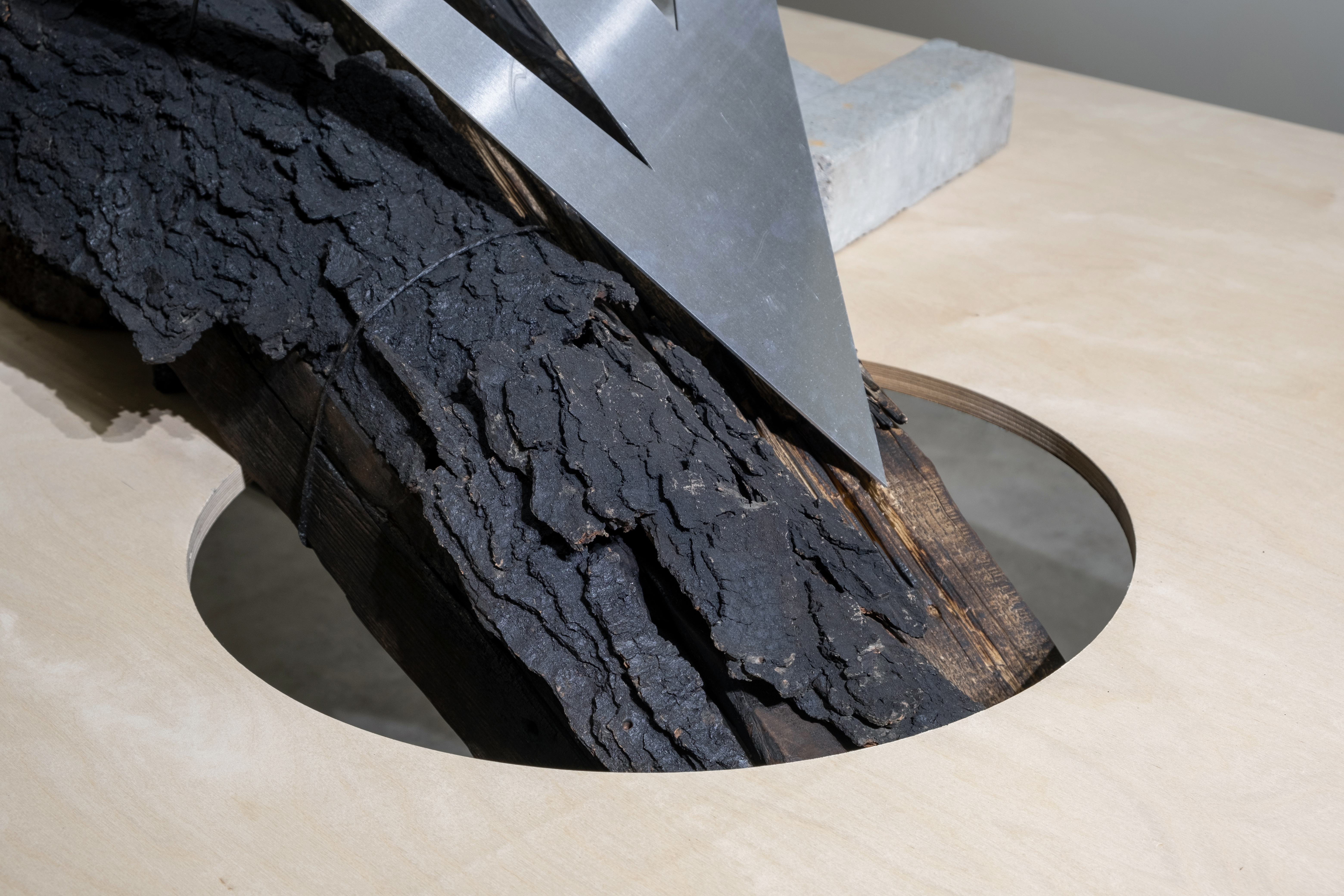

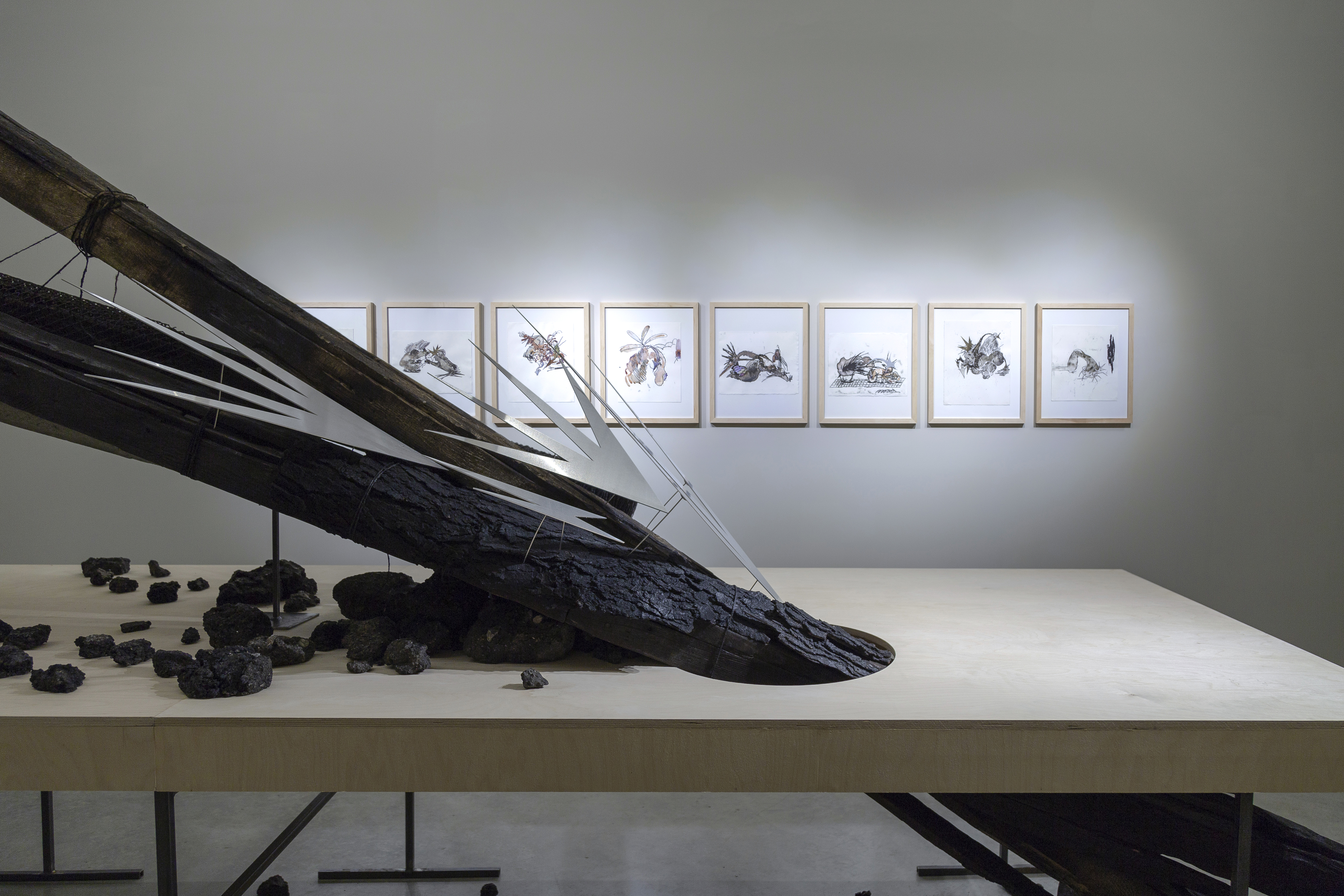

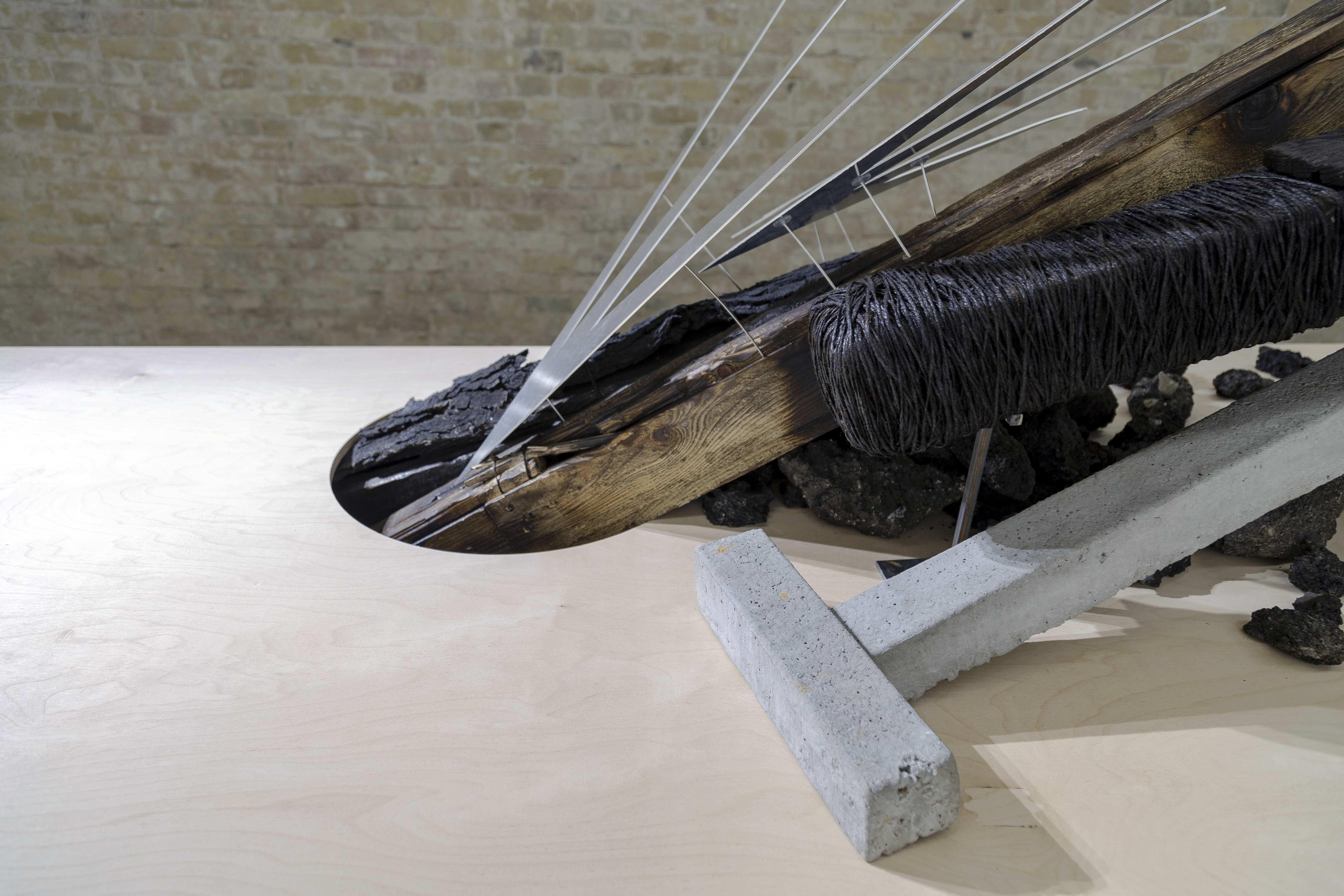







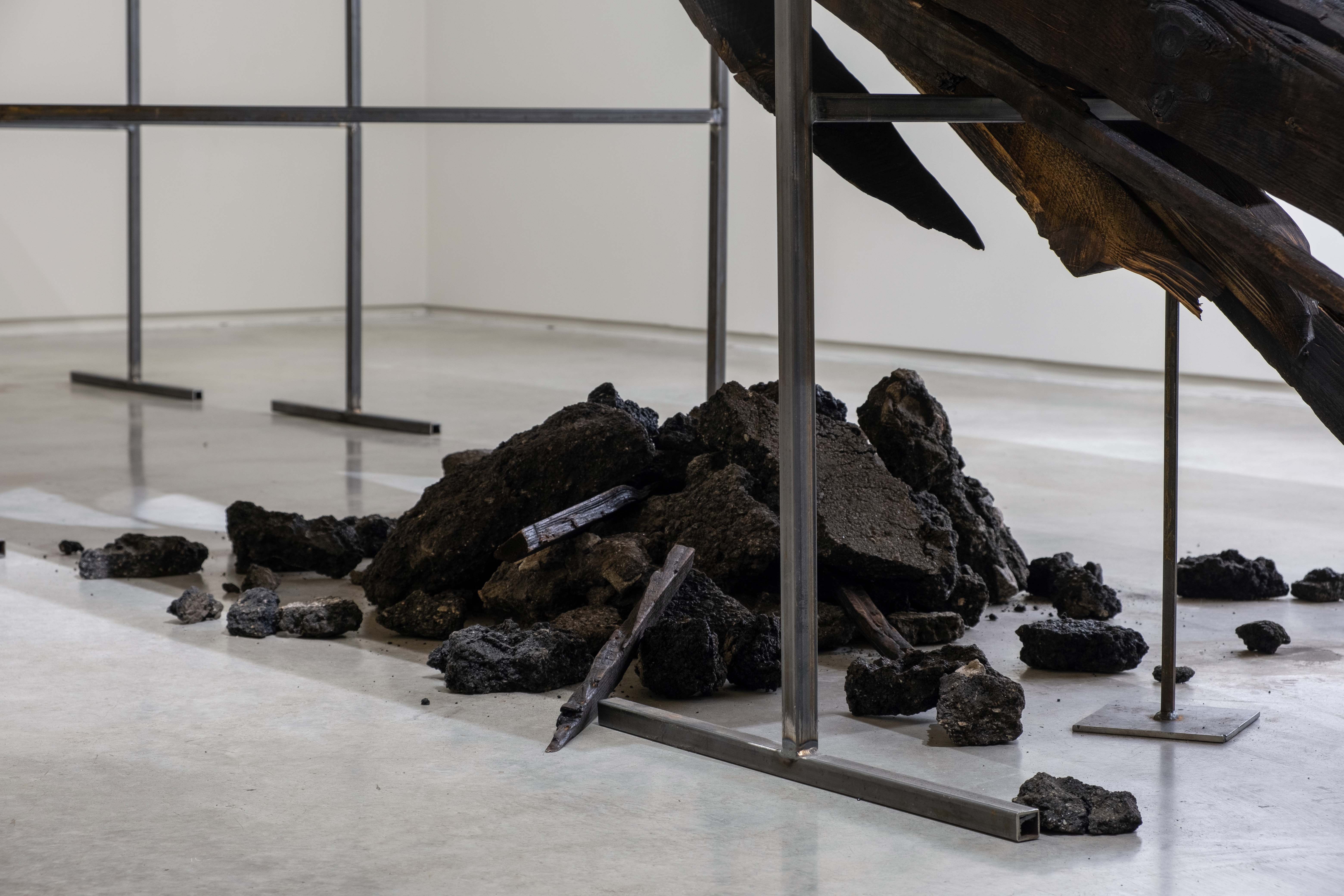



HERBARIUM
2018—21
40х50 cm
Paper, water-color, collage, monotyping, mixed media
︎︎︎ ︎︎︎





HUNTING
2019—20
190x220х25 cm
Copper, wood, firing, welding, bitumen, thread, nails, spray paint
︎︎︎ ︎︎︎
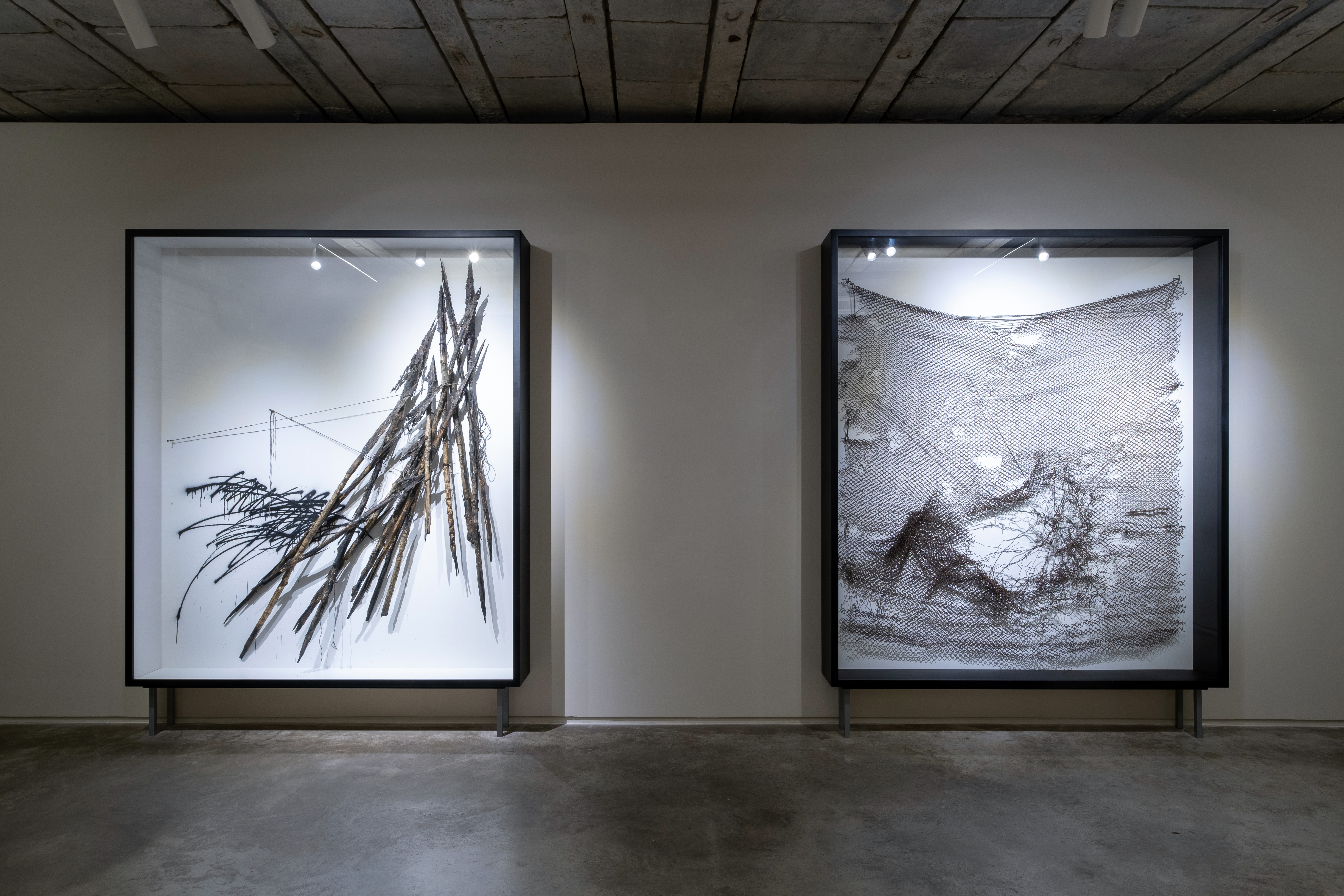





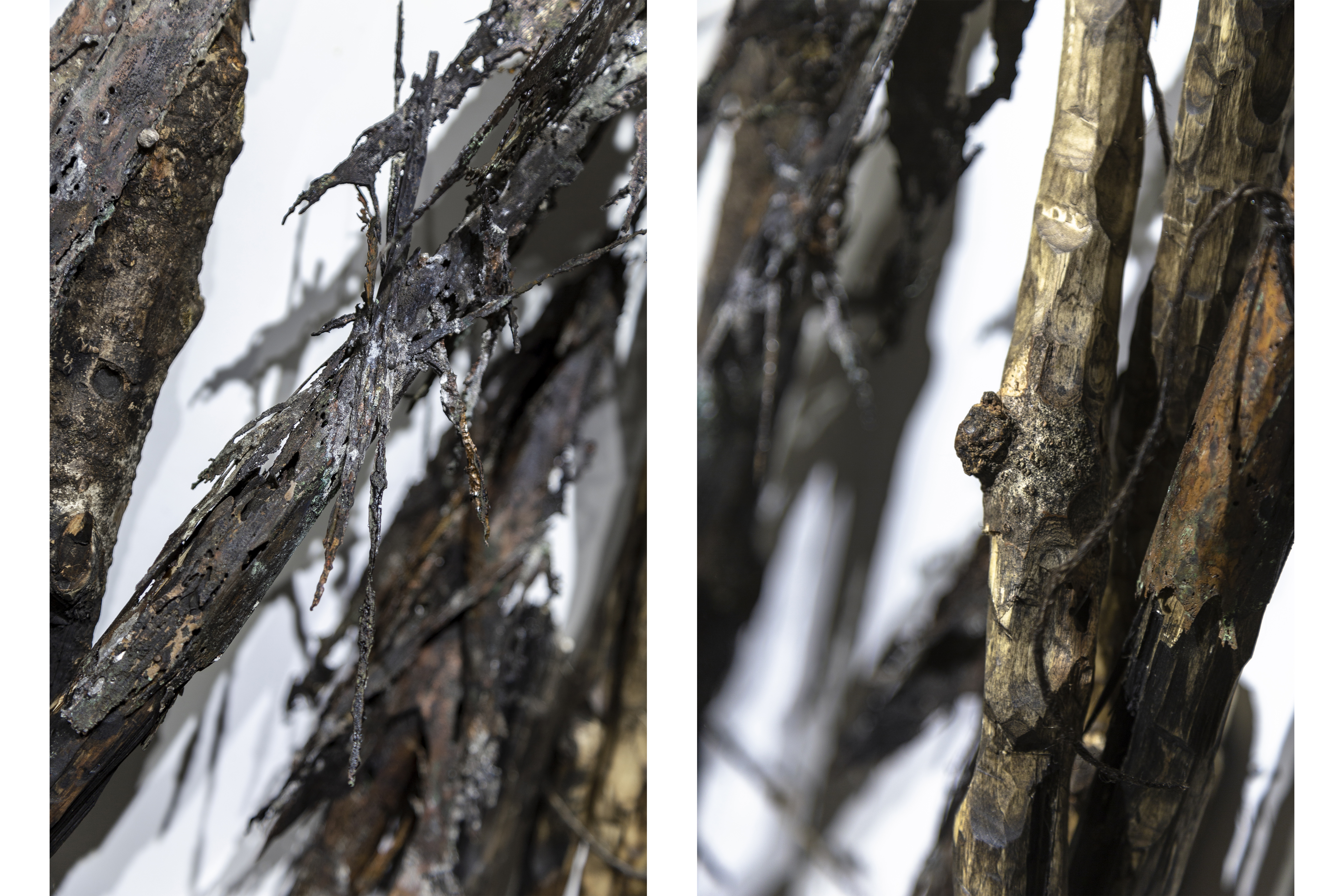





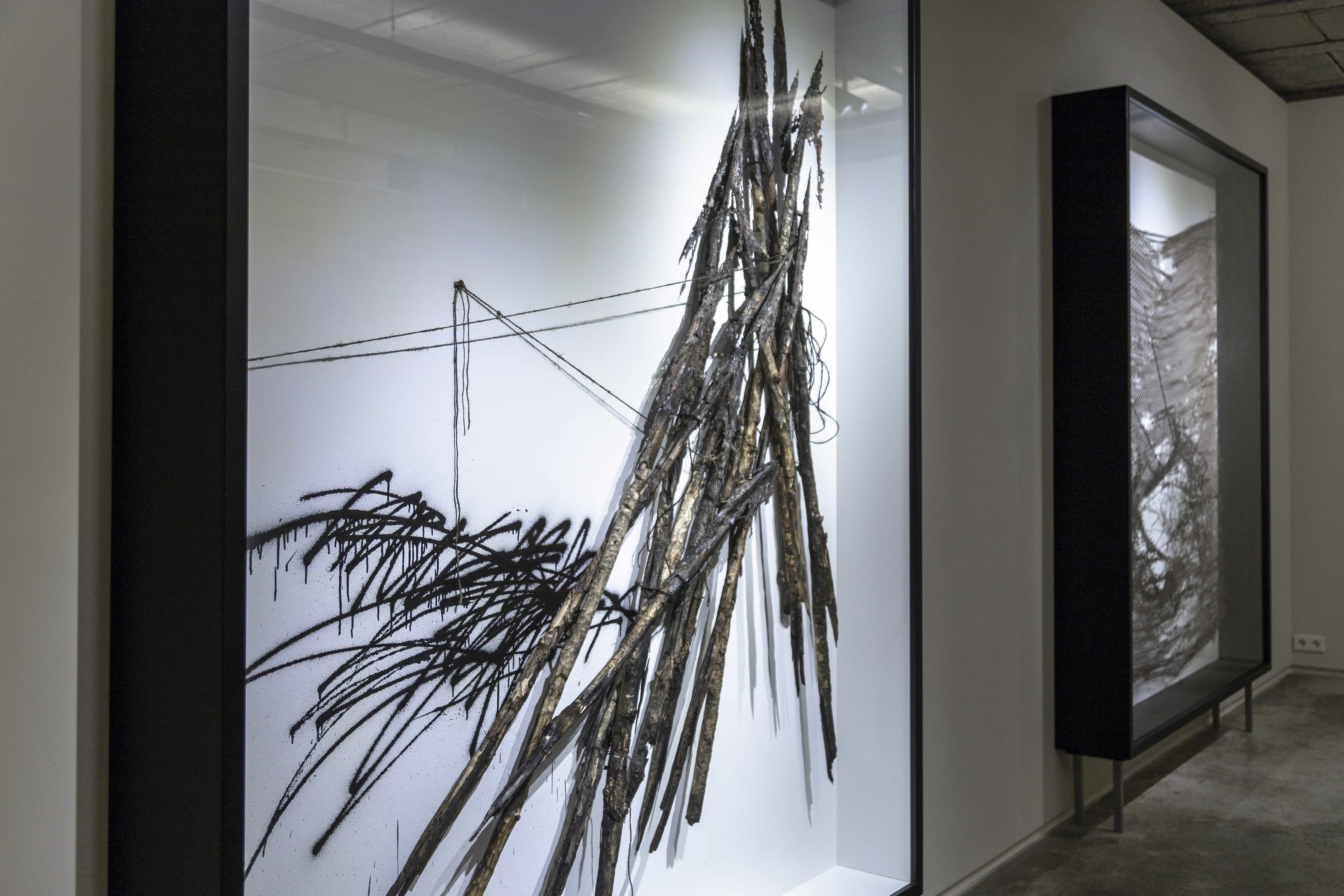
TAKE HEED!
2019
190x220х25 cm
Fencing mesh, clamps, hooks, thread
︎︎︎ ︎︎︎




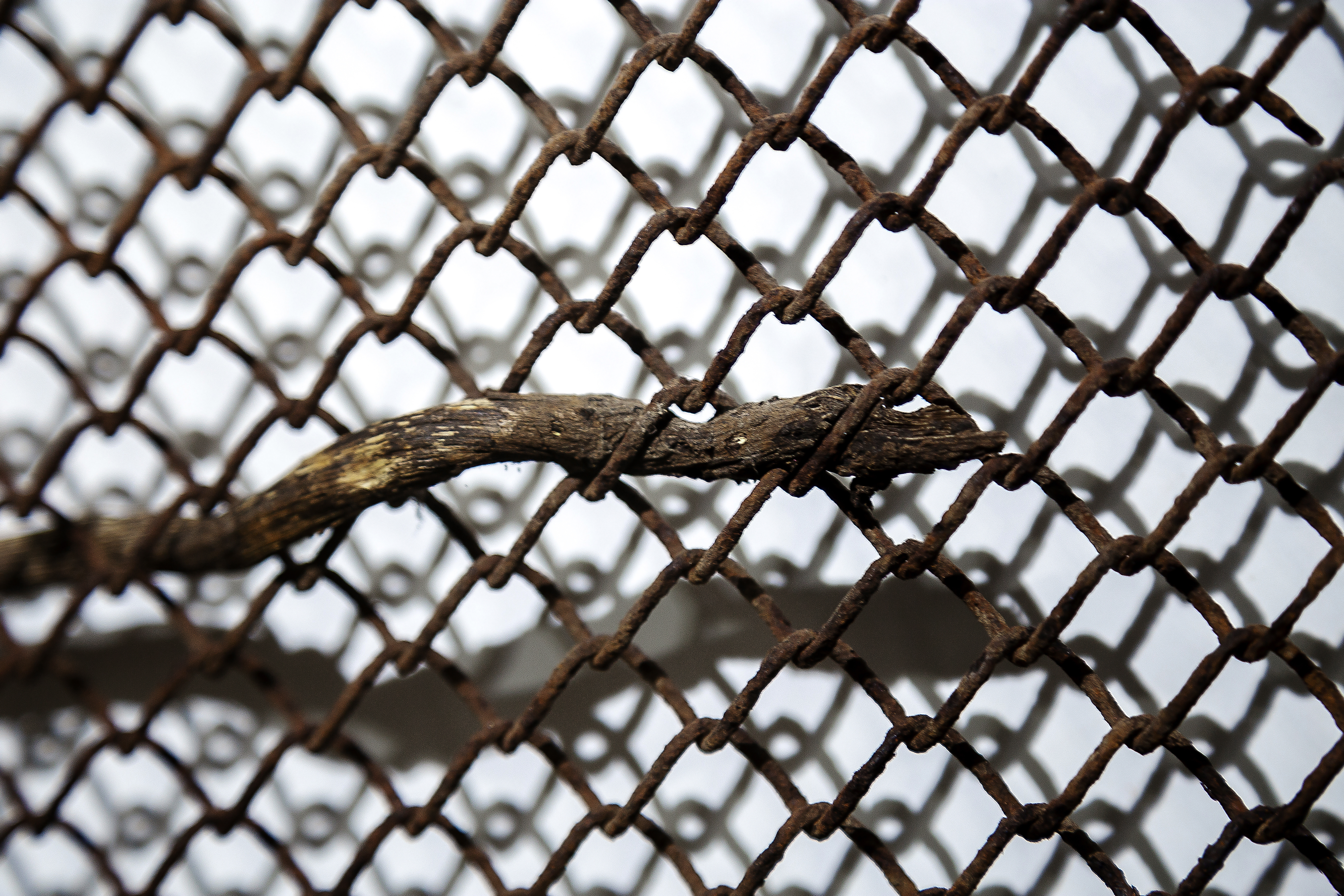



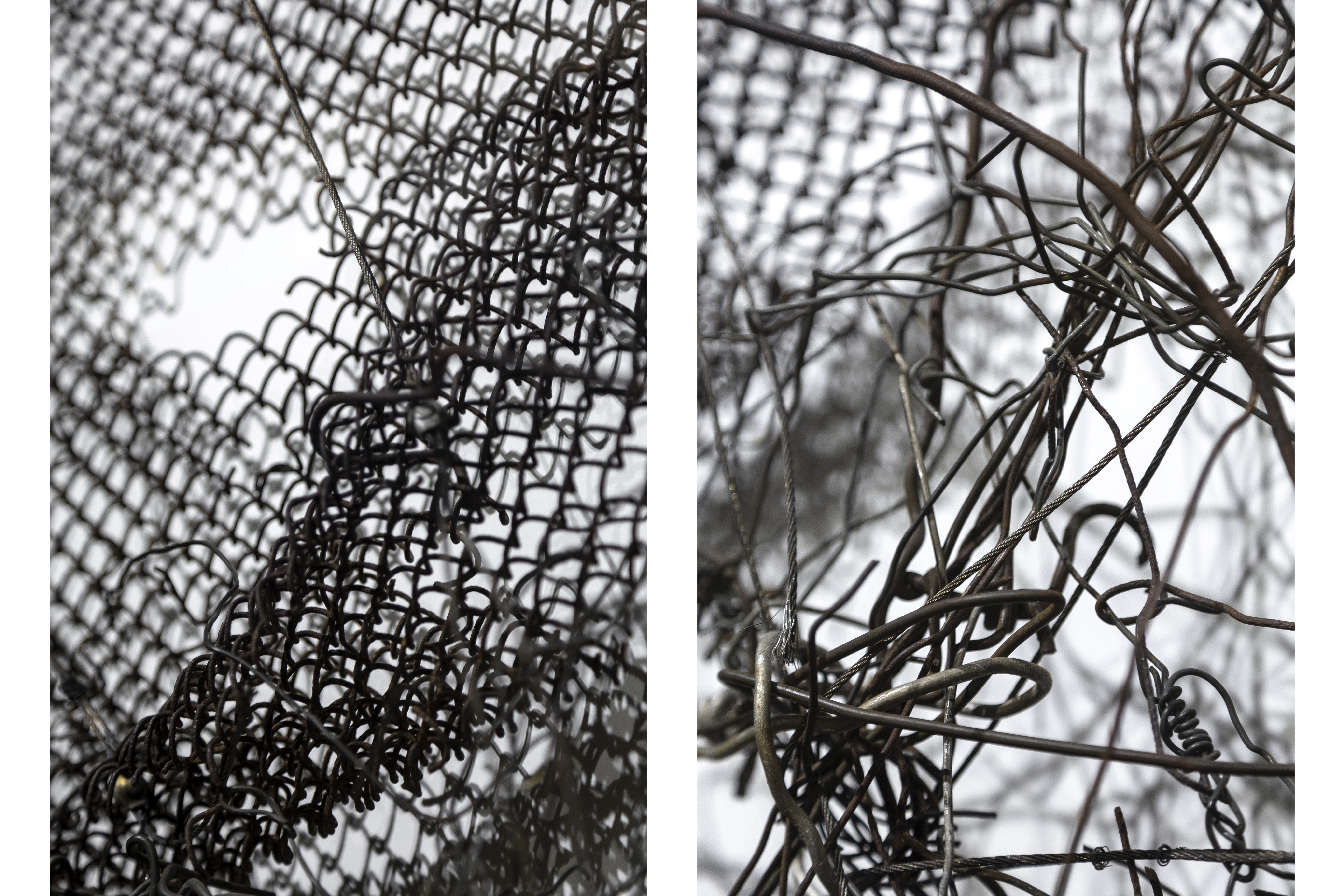




EXHIBITION LAYOUT 'YAGALLERY KYIV'
︎ THE PIT (table 90x120x500cm)
︎ HERBARIUM (50x500x3cm)
︎ TAKE HEED! (190x220x25cm)
︎ HUNTING (190x220x25cm)
